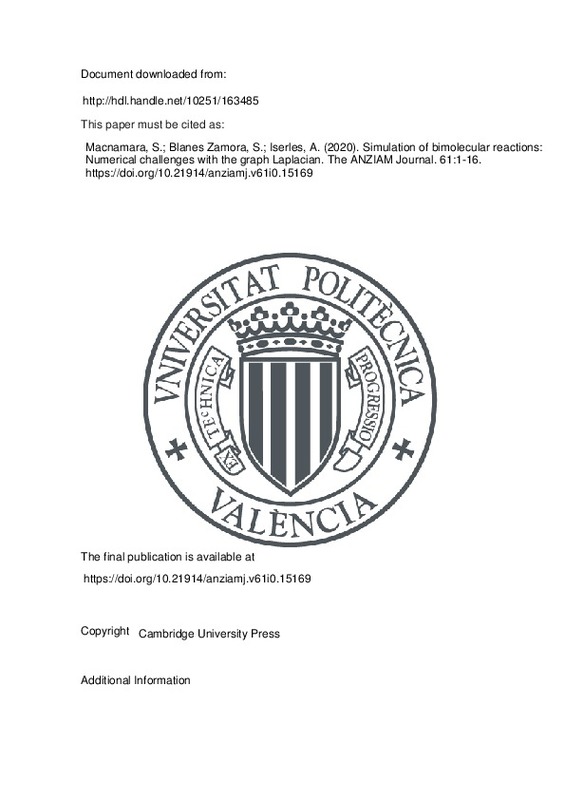JavaScript is disabled for your browser. Some features of this site may not work without it.
Buscar en RiuNet
Listar
Mi cuenta
Estadísticas
Ayuda RiuNet
Admin. UPV
Simulation of bimolecular reactions: Numerical challenges with the graph Laplacian
Mostrar el registro sencillo del ítem
Ficheros en el ítem
| dc.contributor.author | MacNamara, S.
|
es_ES |
| dc.contributor.author | Blanes Zamora, Sergio
|
es_ES |
| dc.contributor.author | Iserles, Arieh
|
es_ES |
| dc.date.accessioned | 2021-03-09T04:32:28Z | |
| dc.date.available | 2021-03-09T04:32:28Z | |
| dc.date.issued | 2020-06-16 | es_ES |
| dc.identifier.issn | 1446-1811 | es_ES |
| dc.identifier.uri | http://hdl.handle.net/10251/163485 | |
| dc.description.abstract | [EN] An important framework for modelling and simulation of chemical reactions is a Markov process sometimes known as a master equation. Explicit solutions of master equations are rare; in general the explicit solution of the governing master equation for a bimolecular reaction remains an open question. We show that a solution is possible in special cases. One method of solution is diagonalization. The crucial class of matrices that describe this family of models are non-symmetric graph Laplacians. We illustrate how standard numerical algorithms for finding eigenvalues fail for the non-symmetric graph Laplacians that arise in master equations for models of chemical kinetics. We propose a novel way to explore the pseudospectra of the non-symmetric graph Laplacians that arise in this class of applications, and illustrate our proposal by Monte Carlo. Finally, we apply the Magnus expansion, which provides a method of simulation when rates change in time. Again the graph Laplacian structure presents some unique issues: standard numerical methods of more than second-order fail to preserve positivity. We therefore propose a method that achieves fourth-order accuracy, and maintain positivity. | es_ES |
| dc.description.sponsorship | We thank the organisers and delegates of the Canberra 2019 EMAC conference for helpful discussions about graph Laplacians. SM thanks the Australian Research Council Centre of Excellence fot Mathematical ans Statistical Frontiers (ACEMS). The work of SB was funded by Ministerio de Economía, Industria y Competitividad (Spain) through project MTM2016-77660-P (AEI/FEDER, UE). | es_ES |
| dc.language | Inglés | es_ES |
| dc.publisher | Cambridge University Press | es_ES |
| dc.relation.ispartof | The ANZIAM Journal | es_ES |
| dc.rights | Reserva de todos los derechos | es_ES |
| dc.subject | Graph laplacian | es_ES |
| dc.subject | Pseudospectra | es_ES |
| dc.subject | Magnus expansion | es_ES |
| dc.subject.classification | MATEMATICA APLICADA | es_ES |
| dc.title | Simulation of bimolecular reactions: Numerical challenges with the graph Laplacian | es_ES |
| dc.type | Artículo | es_ES |
| dc.identifier.doi | 10.21914/anziamj.v61i0.15169 | es_ES |
| dc.relation.projectID | info:eu-repo/grantAgreement/MINECO//MTM2016-77660-P/ES/NUEVOS RETOS EN INTEGRACION NUMERICA: FUNDAMENTOS ALGEBRAICOS, METODOS DE ESCISION, METODOS DE MONTECARLO Y OTRAS APLICACIONES/ | es_ES |
| dc.rights.accessRights | Abierto | es_ES |
| dc.contributor.affiliation | Universitat Politècnica de València. Departamento de Matemática Aplicada - Departament de Matemàtica Aplicada | es_ES |
| dc.description.bibliographicCitation | Macnamara, S.; Blanes Zamora, S.; Iserles, A. (2020). Simulation of bimolecular reactions: Numerical challenges with the graph Laplacian. The ANZIAM Journal. 61:1-16. https://doi.org/10.21914/anziamj.v61i0.15169 | es_ES |
| dc.description.accrualMethod | S | es_ES |
| dc.relation.publisherversion | https://doi.org/10.21914/anziamj.v61i0.15169 | es_ES |
| dc.description.upvformatpinicio | 1 | es_ES |
| dc.description.upvformatpfin | 16 | es_ES |
| dc.type.version | info:eu-repo/semantics/publishedVersion | es_ES |
| dc.description.volume | 61 | es_ES |
| dc.relation.pasarela | S\428759 | es_ES |
| dc.contributor.funder | European Regional Development Fund | es_ES |
| dc.contributor.funder | Ministerio de Economía y Competitividad | es_ES |







![[Cerrado]](/themes/UPV/images/candado.png)

